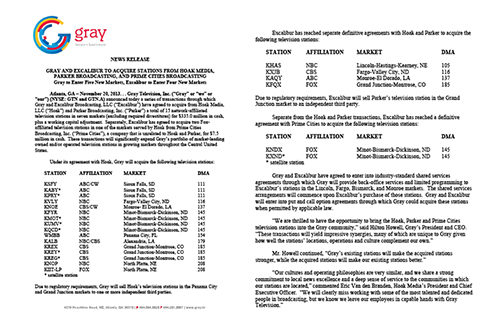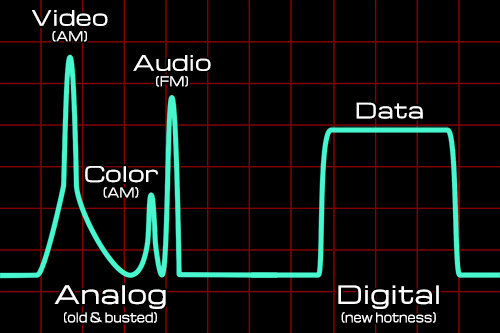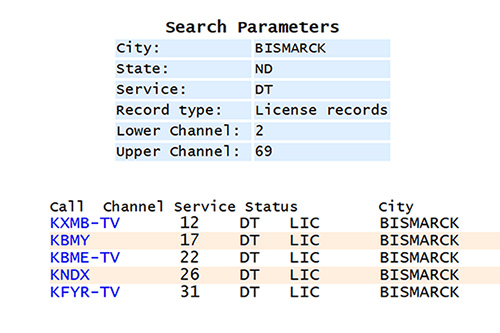 A while ago I posted that the local television landscape would be undergoing even more changes as the Hoak Media stations such as KFYR were being sold again, as was the KNDX cluster or stations owned by Prime Cities. Then, to complicate things, the company that bought the KFYRs, KVLY, and KSFYs signed a tentative agreement to operate the KNDXs. Whee. I bet that’ll make for a busy control room.
A while ago I posted that the local television landscape would be undergoing even more changes as the Hoak Media stations such as KFYR were being sold again, as was the KNDX cluster or stations owned by Prime Cities. Then, to complicate things, the company that bought the KFYRs, KVLY, and KSFYs signed a tentative agreement to operate the KNDXs. Whee. I bet that’ll make for a busy control room.
Well, tonight I finally decided to watch 24 on KNDX instead of the web (I turned it off halfway through, though, to play a game with my little boy) and noticed that I wasn’t getting 26.1 anymore. I knew the transition was coming, but I watch so little television these days that I hadn’t rescanned yet. Sure enough, I picked up FOX on what my television calls “5.2” and no channel 26 could be found.
In case I didn’t mention it here, although I think I did on my blog’s Facebook page, the scuttlebutt I’d heard was for KNDX to move to 5.2, MeTV to eventually move to 26.1, and BEK Communications programming to reside on 26.2 or 26.3. MeTV is still on 5.3, but I don’t expect that to last long. The reason is that any TV station like KFYR only gets 6MHz of bandwidth for their TV signal, and the only way to fit more on it is by compressing the signals digitally – decreasing the picture quality.
 I decided to make this rudimentary graphic (engineers, don’t freak) to give a broad overview of how TV signals are different these days. On the left is the same old snowy analog signal that we grew up with, and on the right is the new digital DTV signal which provides that high definition picture. Both use the same 6 MHz of bandwidth, which means the frequency range for their signal to modulate (think vibrate) in.
I decided to make this rudimentary graphic (engineers, don’t freak) to give a broad overview of how TV signals are different these days. On the left is the same old snowy analog signal that we grew up with, and on the right is the new digital DTV signal which provides that high definition picture. Both use the same 6 MHz of bandwidth, which means the frequency range for their signal to modulate (think vibrate) in.
Note all the ups and downs on the left. That’s because an analog TV signal was actually three different signals: You had the picture, which was an AM signal (like the radio in Grandpa’s car, sorta). This was actually black and white. Then you have the color subcarrier, which put the color information into the picture, also AM. Finally, spaced away from the video carrier by a specific offset, was the audio signal – but this is an FM carrier (like the radio the kids used to listen to in the 80’s).
On the right, you simply have one monster signal, going full blast like a fire hose from end to end (Note: engineers, I don’t think the readers want to hear about sideband right now). What this signal is doing, rather than delivering actual pictures in wavy format, is trying to spew forth as many error-free ones and zeros as possible. What the TV station does with those ones and zeros, however, is where the magic happens.
Say you’re Prairie Public, for example. You put four channels on it: 3.1, 3.2, 3.3, and 3.4. Or perhaps, like KX, you put up one HD channel and one weather channel. KBMY has recently started doing the same thing.
What KFYR has done up to this point is put out a 1080i HD signal for KFYR and a 480i (standard definition) signal for MeTV. This makes sense, as the programming on MeTV was produced for a 4×3, standard definition broadcast picture. But for the time being they now also have a 720p HD signal for KNDX running on the same data stream, meaning that their 6MHz bandwidth has to fit a lot more information on it. I’m sure they’re eager to get MeTV moved over to 26 as soon as it’s technically feasible.
 One other thing that’s noteworthy about Channel 26 vs. Channel 5 is that it is actually Channel 26. When the federal government mandated that stations begin broadcasting digitally only and abandon their analog signal, many stations had to change frequencies. In our area, “Channel 5” is one of these.
One other thing that’s noteworthy about Channel 26 vs. Channel 5 is that it is actually Channel 26. When the federal government mandated that stations begin broadcasting digitally only and abandon their analog signal, many stations had to change frequencies. In our area, “Channel 5” is one of these.
As you can see in the FCC table above, stations with frequencies already within the newly defined broadcast TV spectrum such as KXMB, KBMY, and KNDX were able to keep their existing channels. KBME and KFYR, channels 3 and 5 respectively, weren’t so lucky.
Obviously these stations, and many like them, have spent fifty or sixty years identifying themselves with a channel number, and they’d rather not start from scratch. No worries, though; they’re allowed to identify themselves as their old channel, even though the radio frrequencies they’re using to broadcast their signal are nowhere near that actual channel number. As the chart above indicates, KFYR is actually Channel 31 and KBME is actually Channel 22. You’ll never see them come up on your television that way, however.
The transition from analog television to digital television has been pretty weird. The economic picture of terrestrially-based broadcasting has been equally spooky, with all these stations combining resources to remain viable while spending millions in capital expenses to adopt the new technology. Thankfully, all you have to do to continue receiving the signals over the air at this point is to rescan every now and then to pick up any channels you’ve missed or, in rare cases like this, may have moved.
Update: I’ve been told that there will be no Channel 26 in Bismarck, 24 in Minot. That means what I’d heard through the grapevine about a MeTV/BEK thing on 26, 24, and the low-power stations in Williston and Dickinson is not happening. Channel 5 may be a little more crowded, but all three pictures still look great…so I doubt they’re stressing their available bandwidth.
